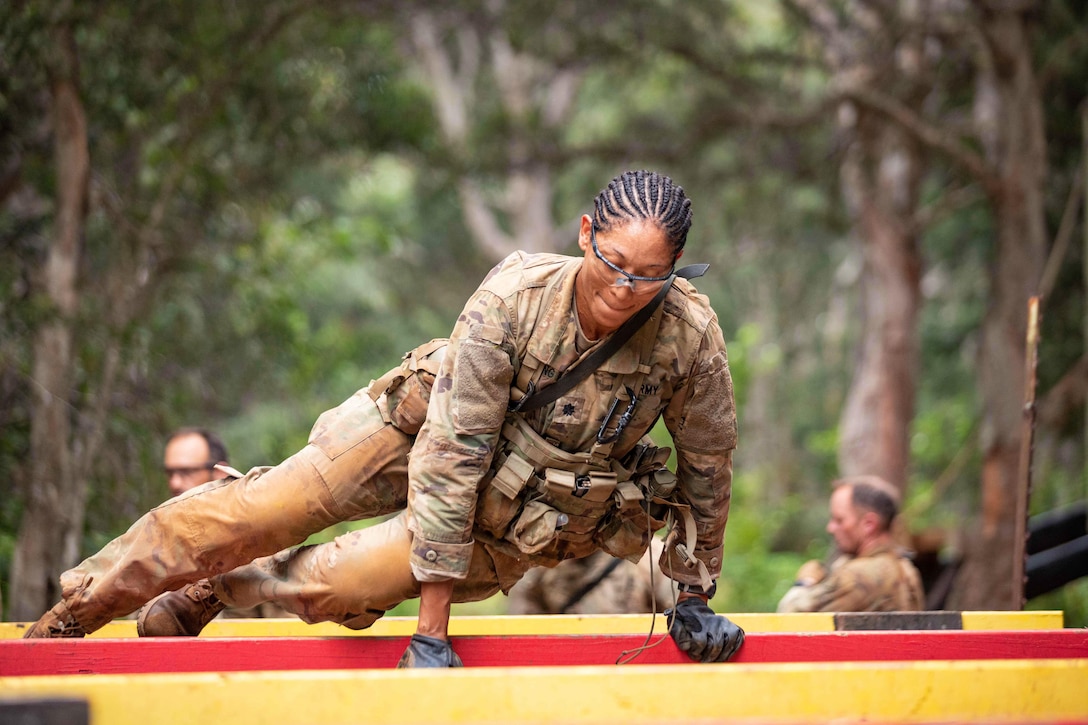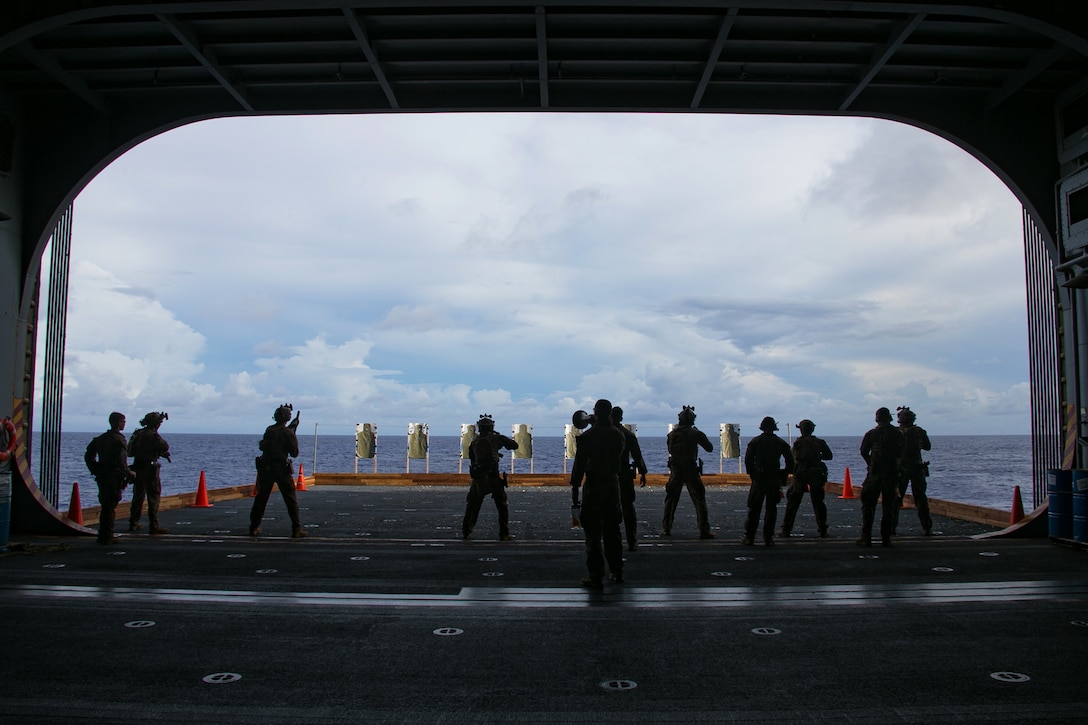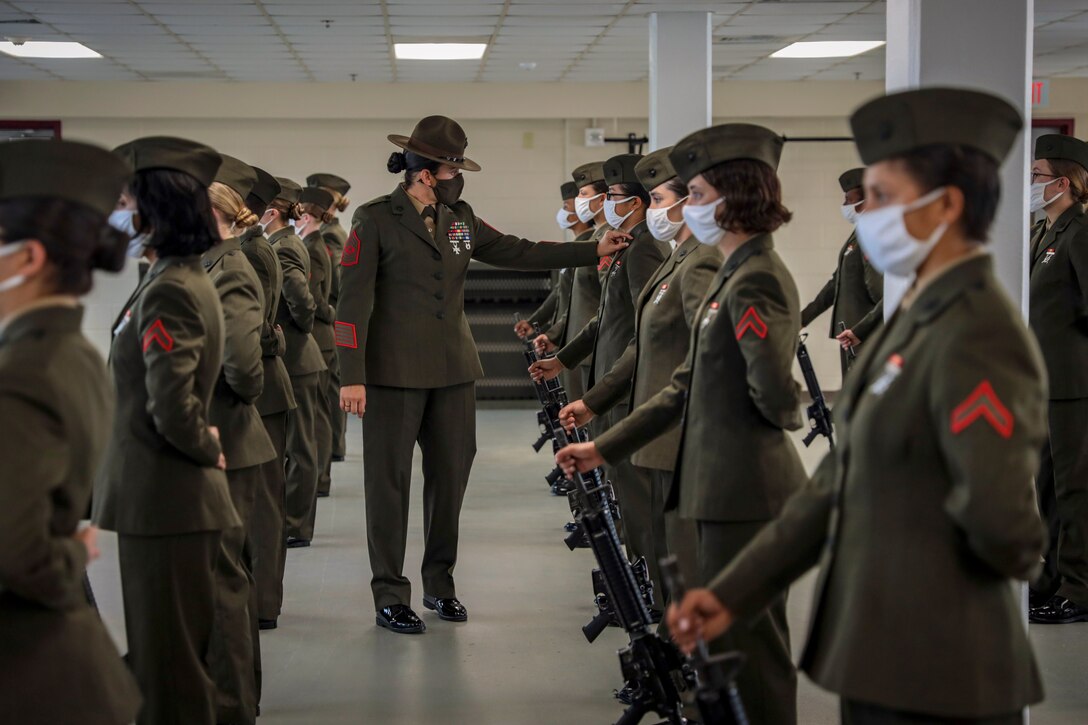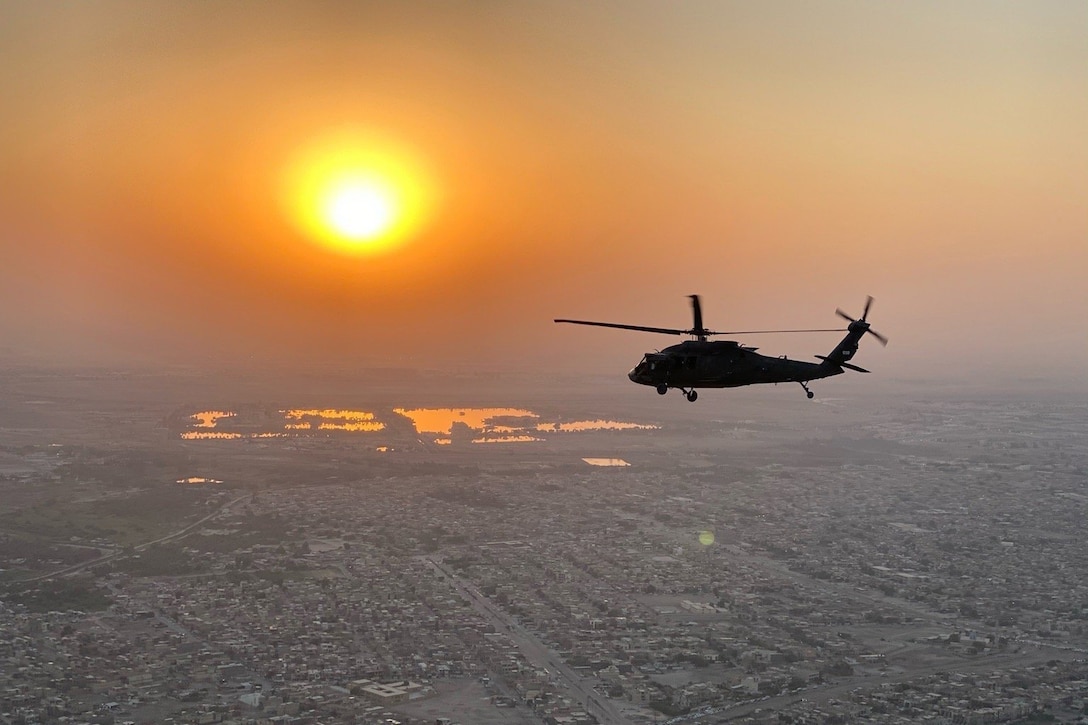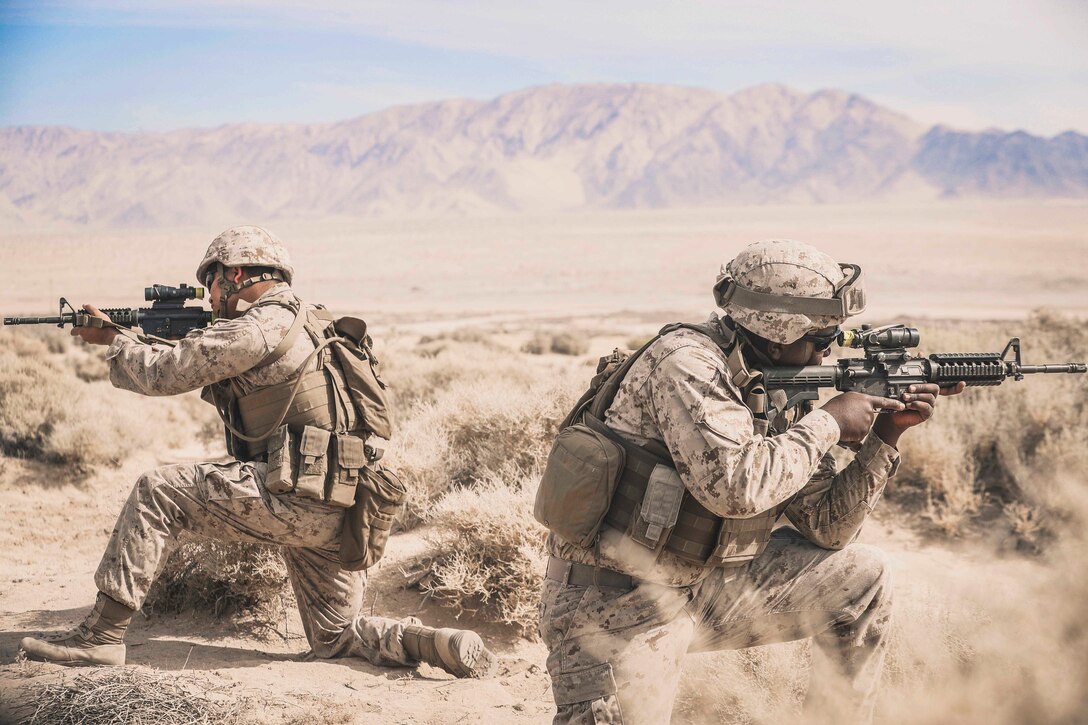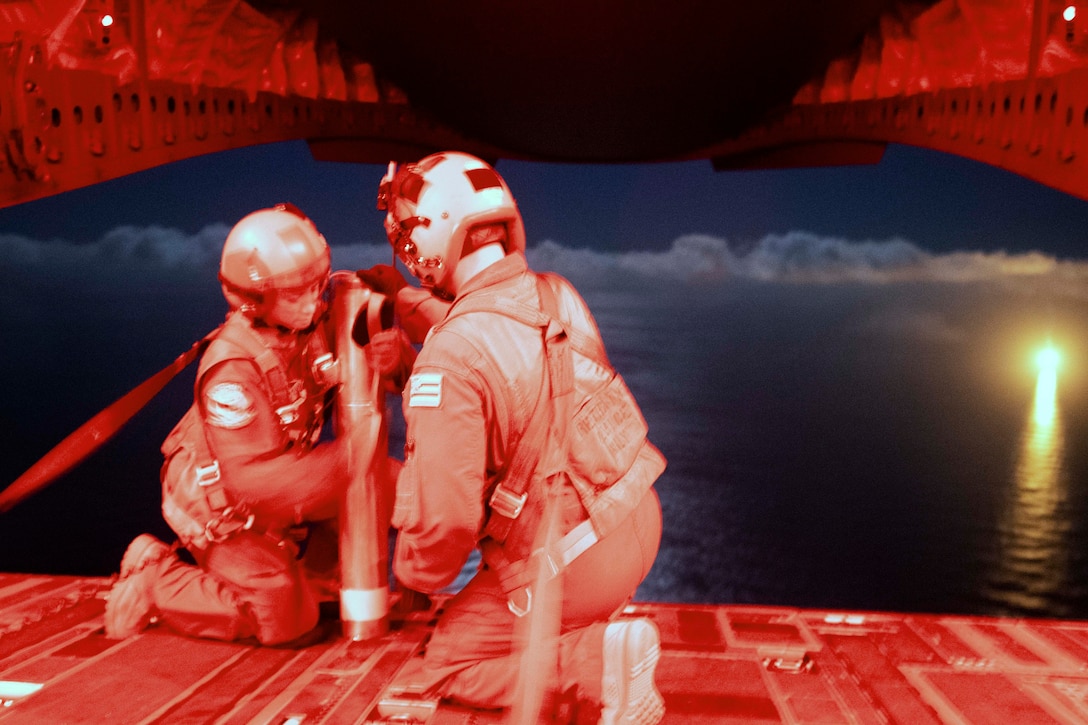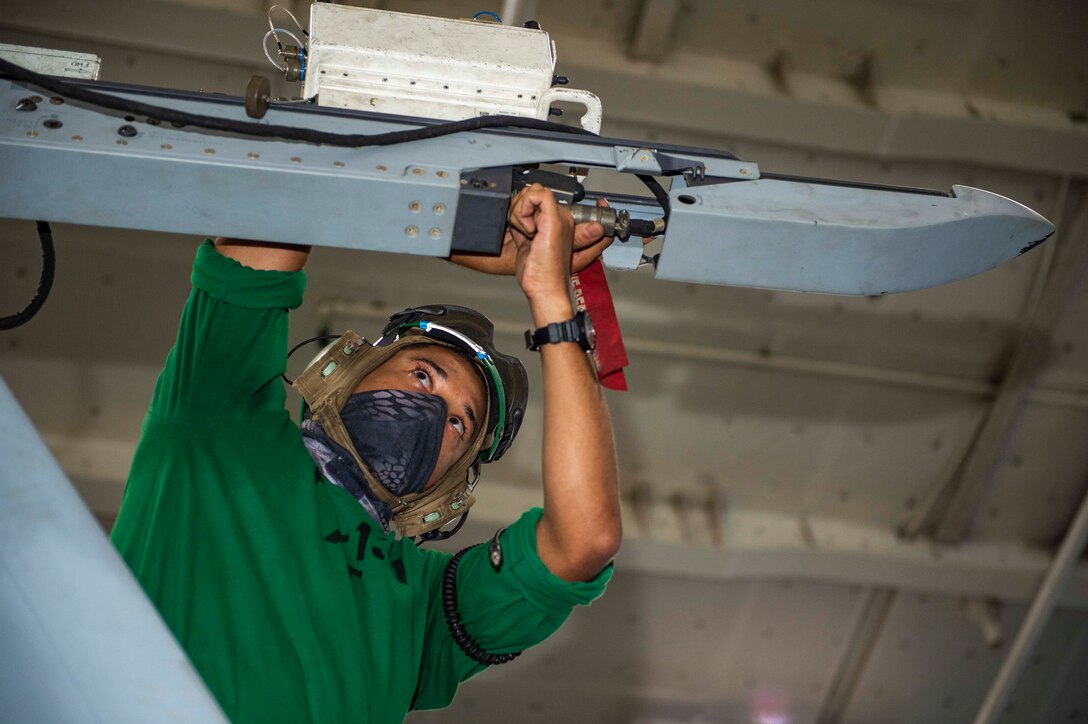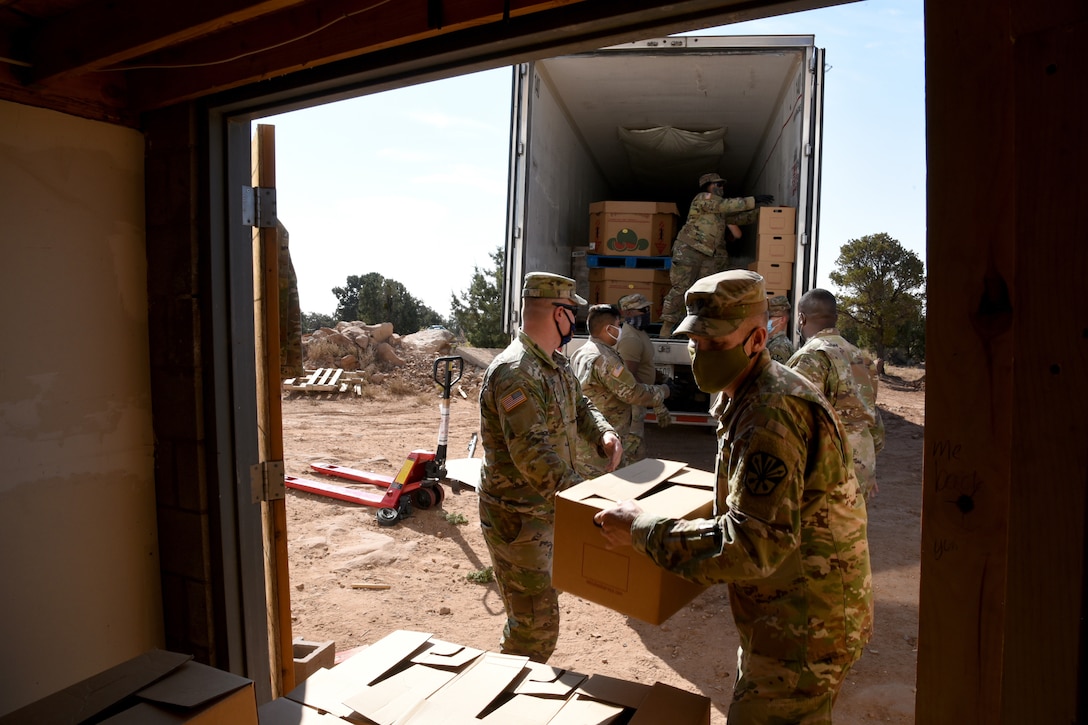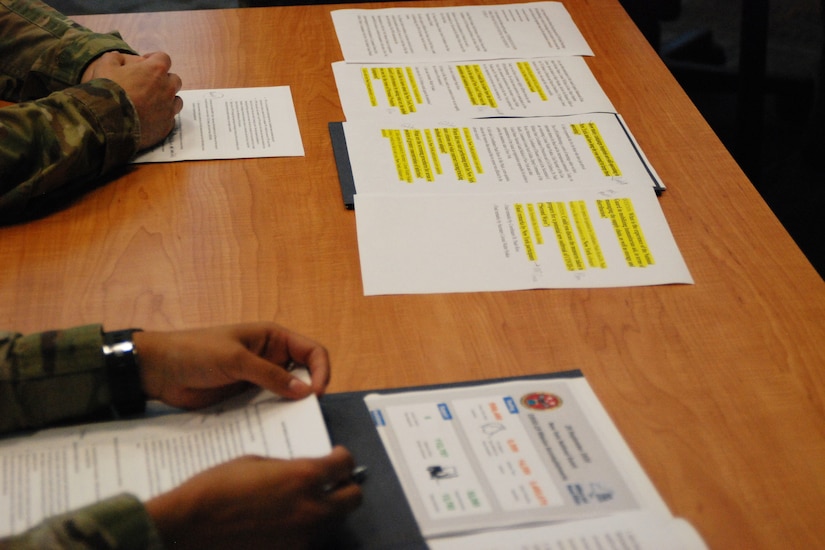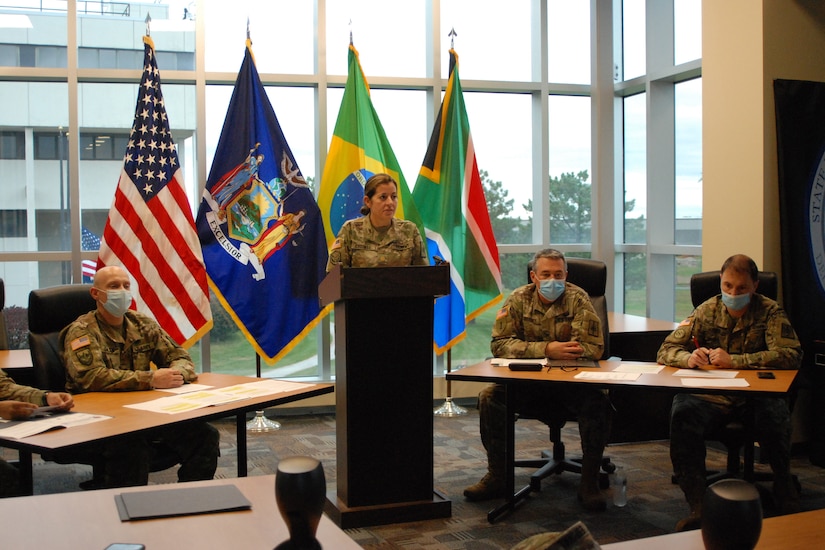Oct. 6, 2020
Secretary Of Defense Mark T. Esper; Tom Mahnken,
President And CEO, Center For Strategic & Budgetary Assessments
CSBA PRESIDENT TOM MAHNKEN: For a quarter century
now, we've been in the business of developing and promulgating new ideas
about national defense, new ideas about policy and strategy, concepts
and capabilities, and budgets and resources. And throughout our
history, we've sought to be an independent, objective voice promoting
innovative solutions to the nation's problems.
Given that focus, it's altogether appropriate that we welcome
Secretary Esper here today to speak about future defense modernization
priorities. So I'd like to turn the floor over to Secretary Esper for
his remarks, followed by a discussion.
Secretary Esper, welcome to CSBA.
SECRETARY OF DEFENSE MARK T. ESPER: Well, good afternoon, everyone,
and thank you, Dr. Mahnken, Tom, thank you for that kind introduction
and for moderating the discussion after I'm done. So it's great to be
back, it's been some time, and I'm pleased that we could do this today.
So it is great again to be here at the Center for Strategic and
Budgetary Assessments, whose nonpartisan research has been instrumental
in shaping national security decisions for more than two decades. In
the years to come, we will need your expertise more than ever as we
continue to implement the National Defense Strategy and adapt the United
States Military to an era of great power competition.
As many of you know, we are doing so along three lines of effort.
First, building a more lethal force. Second, we are strengthening
alliances and partnerships. And third, we are reforming the department
to redirect our time, money and manpower to our highest priorities. I'd
also add a fourth line of effort. That is, taking care of our service
members and their families.
As I reported last summer -- I'm sorry – as I reported this summer,
at my one-year anniversary as secretary of defense, we have made solid
progress on these lines of effort, which we further distilled into 10
discrete objectives. These include tasks such as focusing the
department on China and designing a coordinated plan to strengthen our
allies and build partners, and updating our key war plans.
It also extends to reforming the fourth estate, achieving a higher
level of readiness and implementing enhanced operational concepts such
as dynamic force employment.
I've spoken about some of these accomplishments previously. Today,
I'd like to focus on another key objective: our plans to modernize the
force, specifically our great Navy.
For more than seven decades, the United States Navy has maintained
unmatched superiority on, above, beneath, and from the seas. But this
wasn't always the case. After the Civil War, the United States Navy
fell into decline at a stunning pace. Our nation's bloodiest war had
taken its toll and weary Americans sought to redirect the country's
resources elsewhere.
The size of the fleet plummeted from hundreds of vessels to less than
50, and many of the ships in commission were in disrepair. For a
maritime nation, the United States was ill prepared for a naval
conflict.
That is until a new generation of innovators and forward thinkers led
the charge to rebuild the nation's fleet. At one end were strategic
planners and theorists like Captain Alfred Thayer Mahan and his seminal
work on the influence of sea power. At the other end were statesmen
such as then-Assistant Secretary of the Navy Theodore Roosevelt.
Inspired by Mahan's writings, Roosevelt recognized the outsized
impact of naval superiority in an increasingly interconnected world. As
fate would have it, Roosevelt later ascended to the presidency and,
along with a cadre of likeminded leaders and partners in Congress, set
the Navy on course to becoming the most advanced and powerful fleet in
the world.
We are at a similar historical crossroads today. Over the past
several years, the department had to recover from the crippling effects
of sequestration, inadequate funding, continuing resolutions, and years
of budget uncertainty. We also placed insufficient attention on the
high-end fight, which many believed was behind us with the Cold War's
end.
The good news is that we are now on the road to recovery by first
restoring the readiness of the current fleet and second, by divesting
from legacy systems and lower priorities in order to modernize the
force. We are now at a point where we can -- and indeed we must --
chart a new path to a future fleet that will maintain our naval
superiority long into the future.
Today, cutting-edge technologies are fundamentally altering the
character of warfare and expanding the geometry of the battlefield in
multiple ways. In the maritime domain, artificial intelligence
autonomous systems, ubiquitous sensors, and long-range precision weapons
will play an increasingly leading role in a future high-end fight.
Whoever harnesses these technologies first will have a clear
advantage on the high seas for years to come. Getting there ahead of
everyone else demands a whole-of-nation effort. It will require
innovative thinking backed by first-rate data analysis and modeling such
as the work done right here at CSBA.
It will require a modern industrial base and skilled workforce with
the capacity to match our future needs. And it will require the same
type of bold decision-making that transformed the United States Navy
from a fledgling 19th century fleet into the finest naval force in
history.
The challenge before us today is clear. Near-peer rivals -- namely
China and Russia -- are rapidly modernizing their militaries in an
effort to erode our longstanding advantages and shift the balance of
power in their favor. They want to rewrite the international rules
especially in areas such as freedom of navigation and commerce and are
willing to do so at the expense of others. Moreover, Beijing and Moscow
seek to undermine our military edge through precision long range fires,
anti-access and aerial denial systems, and other asymmetric
capabilities designed to counter our strengths.
The Chinese Communist Party, in particular, intends to complete the
modernization of its Armed Forces by 2035 and to field a world class
military by 2049. At that time, Beijing wants to achieve parity with
the United States Navy, if not exceed our capabilities in certain areas
and to offset our overmatch in several others.
For instance, the PRC is investing in long range missiles and
autonomous unmanned submarines it believes can be cost effective
counters to conventional American naval power. Moreover, the CCP seeks
control over critical waterways, such as the South China Sea, to exert
veto power over the economic and security decisions of smaller nations,
fundamentally undermining their sovereignty and way of life.
Equally troubling are the brazen destabilizing activities of the
People's Liberation Army we are witnessing today, to include sinking a
Vietnamese fishing vessel, intimidating Malaysian oil and gas
development, escorting Chinese fishing fleets into Indonesia's claimed
exclusive economic zone, and militarizing occupied features in direct
contravention of commitments under international law.
This aggression would only grow worse should the Chinese Communist
Party achieve its stated modernization goals and build a military that
can fully implement its nefarious plans. We cannot let that happen.
That is why earlier this year, I charged the Deputy Secretary of Defense
to lead a future naval force study that would assess an ambitious range
of future fleet options designed to maintain our overmatch in this new
era of great power competition long into the future.
The Navy, Marine Corps, Joint Staff, the Office of the Secretary of
Defense, as well as outside advisors, conducted a comprehensive,
cost-constrained, and threat-informed assessment aligned with the
National Defense Strategy.
First, the team examined our current naval forces. Second, they
assessed China's future naval construct. Next, they explored three
force options in order to evaluate a variety of platforms for the future
flight - fight. And finally, they modeled and war gamed these options,
analyzing the strengths and weaknesses of each combination of ships
against different future mission sets.
The team's findings are insightful and serve as an enduring framework
that will drive a major shift in how we design, build and sustain our
fleet and conduct naval operations in the years and decades to come.
The results will enable the department to achieve our objectives in a
timely and cost effective manner, balancing tomorrow's threats with
today's readiness.
In February, I made a commitment to Congress that the department
would submit this year the future naval force study and the 30 year
shipbuilding plan, which is informed by the findings of the study. The -
though delayed by COVID, we are in the process of fulfilling that
promise through proper coordination, beginning with our partners in the
Office of Management and Budget. In the near future, we aim to release
the 30 year plan and provide the study to Congress. But today I want to
discuss the outlines of our proposed Battle Force 2045 that is derived
from the future naval force study.
More work needs to be done in some specific areas and the future
fleet I will describe will be further refined as joint operational plans
are approved, enhanced readiness and deployment concepts are
implemented, advanced technologies emerge, and a new all-domain joint
warfighting doctrine, another one of our top ten NDS objectives, is
adopted.
However, as we look toward the future, if we are to sustain a free
and open international order in the years ahead while also guaranteeing
victory in a high-end fight, should deterrence fail, we propose a future
fleet that optimizes the following core operational attributes.
First, distributed lethality and awareness. Second, survivability in
a high intensity conflict. Third, adaptability for a complex world.
Fourth, ability to project power, control the seas, and demonstrate
presence. And fifth, capability to deliver precision effects at very
long ranges.
At the same time, the fleet design must meet the following
non-warfighting requirements – affordable in an era of tight budgets,
sustainable over the long term and operationally ready and available at
higher rates.
Battle Force 2045 calls for a more balanced Navy of over 500 manned and unmanned ships.
Further, we will reach 355 traditional Battle Force ships prior to
2035, the time at which the PRC aims to fully modernize its military.
And most importantly, we now have a credible path for reaching 355 plus
ships in an era of fiscal constraint.
Under our proposal, Battle Force 2045 will possess the following
characteristics. First, a larger and more capable submarine force. The
study reached a clear consensus on the need to rapidly increase (our
number) of attack submarines, the most survivable strike platform in a
future great power conflict, to the range of 70 to 80 in the fleet.
If we do nothing else, the Navy must begin building three Virginia
class submarines a year as soon as possible. Additionally, we intend to
refuel the seventh Los Angeles class submarine and continue investing
in the future attack submarine SSN(X). Meanwhile, we will continue to
modernize the undersea strategic deterrent, the most survivable leg of
the nuke - nuclear triad.
Second, nuclear powered carriers will remain our most visible
deterrent, with the ability to project power and execute sea control
missions across the globe. And to continue enhancing their
survivability and lethality, we are developing the air wing of the
future, capable of engaging at extended ranges.
At the same time, we continue to examine options for light carriers
that support short takeoff or vertical landing aircraft. One model we
are considering is the USS America [ed. class ship] that is equipped
with more than a dozen F-35Bs. Light carriers provide additional
presence and capacity to carry out day-to-day missions and free up
supercarriers for more critical high-end fights.
While we anticipate that additional study will be required to assess
the proper high-low mix of carriers, eight to 11 nuclear powered
carriers - carriers will be necessary to execute a high end conflict and
maintain our global presence, with up to six light carriers joining
them.
Third, our future force will comprise between 140 to 240 unmanned and
optionally manned surface and sub-surface vessels of all types with the
potential to perform a wide range of missions from resupply and
surveillance to mine laying and missile strikes these are another (key
enabler) of distributed maritime operations. Moreover, they will add
significant offensive and defensive capabilities to the fleet at an
affordable cost in terms of both sailors and dollars.
Earlier this month, the Sea Hunter prototype complete operations with
the USS Russell, demonstrating that unmanned surface vehicles are
technologically feasible and operationally valuable.
Fourth, the future fleet will contained more and smaller surface
combatants. Study results indicate the introduction of 60 to 70 smaller
combatants into the fleet will not only increase capacity to conduct
distributed maritime operations, but it will also free other critical
assets for more efficient mission distribution.
As a preview of where we are headed; earlier this year the Navy
awarded a $795 million contract to purchase the first ship of a new
class of guided missile frigates with the option to purchase nine more
totaling $5.6 billion. This is the first new major ship building
program the Navy has sought in more than a decade and will support the
full range of military options.
Fifth, sufficient strategic lift and logistic vessels are key to the
sustainability of distributed operations. Initial estimates identify
the need for 70 - 70 to 90 combat logistic ships. But further work is
underway to determine if the number of logistic forecasted in this
report are sufficient for the future fight. Our ship building report
will also address our sea lift plans to ensure ground combat forces can
get to the fight on-time and with sufficient combat power.
Sixth, it will possess unmanned ship based aircraft of all types.
The Navy must develop and deploy carrier based unmanned aircraft of all
types. This includes fighters, refuelers, early warning, and electronic
attack aircraft. While this was not analyzed in detail in the study,
we will continue to assess the proper mix and range needed to overcome
tomorrow's threats.
Seventh and finally, we will integrate the Marine Corps new force
design. The Marine Corps is currently in the process of implementing
its force structure plan and I support the Commandant’s visions to
recalibrate to great power competition. As such, we see a need for more
amphibious warfare ships than previously planned, in the 50 to 60
range, but more work needs to be done in this area, as well.
The five operational attributes and three non-war fighting
imperatives I listed above will drive Battle Force 45 to be a more
lethal, survivable, adaptable, sustainable, modern, and larger force
than we have seen in many years. It will also be more balanced. A more
balanced naval force that will have a greater number of smaller surface
combatants and unmanned or optionally manned ships. Along with an
ample submarine force and a modern strategic deterrent.
It will also be able to deliver overwhelming fires balanced across
four domains from the air, from the land, from the sea, and from under
the sea. And it align with the national defense strategy as we optimize
force posture and implement novel concepts that make us more agile,
less predictable, and fully capable of rapidly shifting to combat
operations when needed.
In the years and decades to come, the Navy and Marine Corps will
serve even more prominently under Battle Force 45 as an ever present,
resilient, and dominant fighting force that our adversaries dare not
challenge. We will project power through long-range fires, more capable
ships and next-generation aircraft, linked by advanced sensors and
enabled by A.I., to stay ahead of the competitive and retain our
decisive over match for decades to come.
We will employ Marines, trained and equipped for littoral warfare,
synchronized with unmanned systems and networked to the advanced weapons
systems and firepower of the total force and we will operate at the
forward edge of American interests as the Navy and Marine Corps team
have always done, providing a highly visible deterrent and positioning
us to win the joint fight at a moment's notice.
Achieving Battle Force 2045 over the long run will not be easy.
Parochial interests, budget uncertainties, industrial capacity, and
other competing factors will contest our ambitions. As a plan for the
future we would do well to learn from the past. Last week I had the
opportunity to visit Malta, whose partnership with the United States
dates back to the Revolutionary War. In 1804, the U.S. deployed one of
its six original frigates, the U.S.S. Constitution, to Malta to combat
piracy. At the time, these six frigates represented a remarkable
whole-of-nation achievement for a country still in its infancy.
Through the Naval Act of 1794, Congress initiated the construction of
what would soon become the Corps of the United States Navy. Instead of
converting merchant vessels into warships, the final designs called for
a more innovative approach, to build the six craft from the keel up,
with features that would give these ships the power to dominate other
frigates but also the speed to outrun larger ships of the line.
Moreover, rather than consolidate the manufacturing at one shipyard,
Secretary of War Henry Knox advocated for six sites in six different
states with timber and other materials sourced from throughout the
union. Standing up our nation's firstly was as much an exercise in
bolstering national defense as it was in promoting a diversified
industrial base that drove economic growth and innovation across the
country.
We intend to pursue a similar approach for Battle Force 2045. To
start, we have charted an incredible path to reaching 355 ships that
works within real world budget constraints. Through its own reviews and
reforms, the Navy did good work these past several months, bringing up
funds in the coming years for the building of new ships. The Navy must
continue these initiatives; they are essential to ensuring an adequate
shipbuilding account for the task ahead.
Given the serious reform efforts put forward by the Secretary of the
Navy and the Chief of Naval Operations and their commitment to continue
them, I agreed to provide additional funding from across the Department
of Defense enterprise, funding that was harvested from ongoing reform
efforts such as combatant command reviews, Fourth Estate reforms, and
other initiatives. Together, these additional funding streams will
increase the shipbuilding accounts to 13 percent within the Navy's top
line, matching the average percentage spent for new ships during
President Reagan's build-up in the 1980s.
Additionally, we will need assistance from Congress to achieve Battle
Force 45. To deliver this future fleet, we first need Congressional
support for sustained, predictable, adequate and timely budgets, which
means no more continuing resolutions. Second, the Department must be
able to divest from legacy systems and lower-priority activities and
then redirect those savings to our highest priorities.
And finally, we request statutory authority to put unused end-of-year
Navy funding directly into the shipbuilding account, with appropriate
congressional oversight, instead of watching it expire. The combination
of these funds, reforms, and authorities will help ensure that Battle
Force 2045 is adequately resourced.
Furthermore with respect to our industry and private sector partners,
we understand the challenges in building a robust and healthy
industrial base with modern shipyards, quality infrastructure, and
highly-skilled workers. I have met with and personally spoken to many
industry leaders over the past year about these issues. We believe our
proposal provides predictability for the supply chain, top-to-bottom,
along with the sustainable demand you need to invest in, train, and
retain a (talented work force).
Likewise, we will need industry support to fulfill our vision by
delivering innovation on time and on budget. Investing in game-changing
technologies is another top 10 NDS objective upon which we are making
solid progress. Designing a future fleet built upon these
next-generation technologies and concepts is not just bold, but
imperative to maintaining our advantage. The keys to delivering the
cutting-edge technology, leveraged by Battle Force 45, (are early)
testing, (prototyping, and) operational experimentation.
On a recent trip to California I saw firsthand how American
entrepreneurs are doing just that, as they advance the development of
autonomous surface and undersea vehicles. We have already witnessed
successful demonstrations with the Sea Hunter as well as the
extra-large, unmanned, undersea vehicle and we are planning training
events to continue developing tactics, techniques, and procedures for
these platforms.
We also recognize what has been the Navy's Achilles' Heel – shipyard
capacity and maintenance delays. We cannot build and sustain our
proposed fleet without the ability to service and repair a greater
number of vessels in a more timely fashion; nor can we sacrifice
shipbuilding for maintenance. The objective is to have as many ships
continuously at sea as possible. To maintain a high level of readiness;
we must do both. We can do both. We will continue our efforts to
revitalize and expand the Navy's four shipyards while promoting
partnerships with private shipyards across the country without pulling
from the shipbuilding account.
To our friends right here at CSBA and across think tanks and
academia, we need your innovative research, ideas, and analysis to
refine Battle Force 2045 and our war-fighting concepts and to drive the
decision points that will keep us ahead of the competition.
Finally, to our allies and partners around the world, we will
continue to uphold the international rules-based order and norms that
have benefited all of us for generations. Our Navy will continue to fly
and sail and operate wherever international law allows. But as we
invest more into our Armed Forces, we need you to do the same and we
need you sailing alongside us for the sake of our collective security
and global stability.
Over the past year I have visited with all types of U.S. Navy ships
and units, from submarines and destroyers to aircraft carriers and large
deck amphibious ships and including a variety of unmanned vessels as
well. I can assure you that we command the best and the most capable
Navy on this planet. Nations around the world look to us to preserve
freedom in navigation, protect the global commons, and deter aggression
from competitors and adversaries alike.
Our brave sailors and Marines will continue to do so now and long
into the future so long as we deliver a future fleet that meets the
needs of our great country and the demands of an increasingly complex
security environment. If we can assemble the collective will and
determination to see it through, I am confident that Battle Force 2045
will maintain our maritime superiority far into the future and ensure
the United States Navy remains the greatest in the world for generations
to come. Thank you.
MR. MAHNKEN: Well, thank you. Thank you, Mr. Secretary for those
remarks and there's a lot to dig into. And we've collected a number of
questions to kind of continue the conversation, but in fact, before I
get to my list here, just a question really about you being here giving
this speech about the future Navy. I mean I think, my personal view
that it's a great thing when one service gets the attention of the
secretary of defense, the big boss. But you know there's also sort of a
narrative out there that this -- (somehow) represents a failure as a
Navy or something like that. What message are you trying to send by
really personally delivering this message about the future of the Navy?
SEC. ESPER: Well, I think as I said in my remarks, the Navy for
generations has been absolutely critical to the national security and
also the economic security of our country and will remain so in the
future; and the challenge before us is to maintain the greatest Navy in
the world and I recognize that. I recognized that as Secretary of
Defense from day one; this is why I made it a priority. It's not news
to anyone that the Navy has wrestled with the challenges of maintenance
and training and readiness.
And so when I came into office I made this the priority, working with
the CNO at the time and the Secretary of the Navy and so that's why
it's so incredibly important to me; it's also very important to the
president, it's very important to Congress and so the ability for me,
for this time, attention and efforts on subjects as important as the
nation's security as this is important. And so that's why I feel a
personal responsibility and it should not be taken that the message is
just because I'm delivering it means only I'm behind it. That's not the
case. We work hand-in-glove with entire Navy/Marine Corps team, our
OSD staff, others outside of the building as well, and the position I
take and the remarks I gave today are fully supported by the Navy/Marine
Corps team, my team, CAPE, the OSD staff; we believe that this is the
vision for the future that will ensure that we maintain the greatest
Navy in the world, and we can deliver the national security and economic
security that the United States (needs) for decades to come.
MR. MAHNKEN: Let me pick up on one of your themes in your remarks,
which is balance. And I know one of the challenges that you face on a
day-to-day basis -- it's not, like, you know, weekly is -- is striking
that balance between the priority that you outlined, modernization, and
day-to-day requirements, and certainly when it comes to naval, of
course, is Navy/Marine Corps, that's a very common consideration. How
do you think about striking that balance? And how do you think we
should think about striking that balance going forward?
SEC. ESPER: Well, you touched upon a very important word that I
emphasized a few times in my remarks that we've talked about throughout
the course of the last several months within the building. That is a
balanced force, and so as we looked at the challenges ahead and as the
studies were conducted, we looked at how do you balance surface,
sub-surface, effects from the air, effects from the ground, and what we
came up with the future force, Battle Force 2045 is a more balanced
force, allows us to conduct all those missions that are critical to the
Navy's success.
And now, the other issue that you're tagging on is the one that has
-- has -- has been a constant challenge and has been for me and my
predecessors, who do you balance of today the readiness of today with
investment in the future?
And clearly that has been a challenge, particularly with the Navy,
because the demands placed on the sea surface from the Combatant Command
as they face threats and challenges in competition, whether it's in the
Indo-Pacific, EUCOM, or the CENTCOM AOR.
And so, I had the privilege of seeing this tension as a service
secretary and as I -- as I fleeted up, as you will, got into the
Secretary of Defense job, I brought that background as well and made a
commitment to make sure that I worked closely with the Navy to help
strike a better balance, one that will allow them to -- to get on a
better path to readiness, but at the same time, make sure that we were
doing the day-to-day business that was demanded of the Combatant
Commanders.
That said, as the NDS, the National Defense Strategy tells us at the
end of the day, while we have to do both, it's more important to
prioritize modernization and future readiness over the demands of
today.
That's why we have identified economy of force theaters, if you
will. That is why I have conducted a series of combatant command
reviews in order to optimize our forces that are serving under
respective Combatant Commanders and optimize them for the mission. So,
that could do a few things, either reties them to the Indo-Pacific, our
priority theater, or return them back home to retrain, to refit, to
build maintenance and readiness.
So, that is the balance that -- that is the tension that I experience
every day. I take good advice from all of my advisors, the Joint
Chiefs, the Chairmen, OSD Staff, that that is the thing that we continue
to work on and I think the Navy is on a good path. But we've got to be
able to do both and the plan we set forth today will allow us to
maintain that near-term readiness we need, build the future fleet
without creating a hollow Navy, that's the important thing.
MR. MAHNKEN: Well thank you. You -- in laying out Battle Force
2045, you laid out an ambitious set of things that need to happen and I
think you did good job of portraying just how massive that enterprise
is.
Fleet modernization, sea-based nuclear design modernization, ship
yards, new concepts, new capabilities, and you talked a little bit about
the barriers, but I guess, as you think about going forward and
implementing that -- you know, that vision, how do you see the
priorities within -- within that vision? The different components?
SEC. ESPER: And so, well first and foremost, one of the most
important things we had to modernize the strategic triad, and not just
the sea base, but all legs of the triad, and we have invested enormous
sums and put a great deal of effort into that and I update myself
quarterly from the team on our progress in terms of doing that.
So, we will, of course, maintain the strategic leg -- I'm sorry --
the -- the under sea leg of the triad, it's our most survivable one and
I've -- I've been up to the ship yard to check on the progress. And so,
that will always be priority number one.
Priority number two then is, as you look at in Battle Force 2045, I
noted this is my remarks, but there was clear consensus over months of
study and war-gaming and analysis that we need to build more submarines,
more attack submarines.
And if we do nothing else we should invest in attack submarines,
because of the lethality that they can deliver under the sea and the
survivability that they have in clear overmatch that we have when it
comes to the under sea domain and submarines in particular. So that
would be first priority when you think about conventional side of the -
of Battle Force 2045. Next, you've got to look at the (inaudible)
lethal effects and then we start talking about, you know, smaller
surface combatants being able to - to deliver those fires.
The key thing we took about - I take from the study and from a - my
own - my own work on these topics is that what's increasingly becoming
more and more important is the ability to deliver long range precision
fires accurately, in volume, enabled by A.I., and linked through
ubiquitous sensors and - and - and networking to do that. That's - that
is - seems to be essential right now and that will increasingly - I - I
believe drive how we think about warfighting in the future, and not
just in the naval domain but in all domains - in - in - in air and
ground domain, as well.
MR. MAHNKEN: What - picking up on that, you talked about precision -
precision fires and, you know, in your remarks you wrote - you know,
you referred to history, you know, a number of times. I think at least
history shows me or tells me, it's really operational problems,
operational challenges really serve as the spur of - of innovation.
I - I know the 2018 NDS has its own list of operational problems,
it's classified. The National Defense Strategy Commission, which I was a
part of, had our own list that was unclassified. More recently,
there's been a - a proposal to say "well, we should adopt a goal of, you
know, seeking large numbers of - of Chinese ships within the fixed, you
know, short time period as a - as a driver for innovation."
I guess what - what's - what's your response to a proposal like that
narrowly, but more generally, you know, the need for some concrete
problems to - to drive us as we move forward?
SEC. ESPER: Well you - you don't build a force, whether it's a air,
ground, or - or - or naval force around a single scenario, if you will.
We do know we need to build a force around the high-end fight and that
includes multiple scenarios.
But the Navy also has an ambitious mission set that includes
peacetime activities, competition activities - you have to demonstrate
presence - forward presence, the ability to control sea lanes, the
ability to work with partners and allies and do those things.
So any one day, we have nearly 100 or so ships deployed doing these
things. So - so you - you don't build a force around a single
scenario. That said, we know the challenges that are before us. One of
the things that I set out to do as my top 10 list of implementing the
NDS is to make sure we update our war plans and we are well on the way
to doing that. So that's one thing we're making solid progress on.
But the reviewing and updating war plans informs us of how the fight
may look. That - that also is helpful in terms of framing up the future
fleet architecture. We also know, as I mentioned, that we're going to
develop a joint warfighting concept. That will (drive) additional
change.
So as we think about this, we think about how do you build a - a
fleet that can do the full spectrum of operations, from peacetime
engagement all the way to the high end fight, and make sure you can
handle those - those difficult scenarios?
Then you have to think through, well, what's the best way to do
them? I (inaudible) and (inaudible) how - how might that fight play out
and that's where I go back to. We looked at how do you deliver effects
from the air, from the ground, from the sea, and from under the sea.
And that's what drives you to this more balanced force, this battle
force 2045 that gives you the ability to deliver those effects, lethal
effects consistent with the NDS, at - at a more survivable way of doing
so through distributed ops, et cetera, et cetera.
So that's kind of how we - we - we look at the problem set, if you will.
MR. MAHNKEN: Well thank you for that. And let me - let me actually -
let me - let me - let me push you on a scenario. So, talked about
China being a priority and I think one of the - one of the priority
contingencies to think about when it - when it comes to China has to do
with Taiwan and (inaudible) the - the military balance across the Taiwan
Strait as - has been shifting. The most recent Military Power Report
illustrates that in a number of ways.
Presumably, this - you know, the - the - the future force will be
more - more capable, adopting the attributes you talk about, to include,
you know, the Battle Force 2045, including every - every other aspect
of the joint force.
I guess the question is, you know, if we move in this direction with
these changes, are - are - are we going to be able to - to prevail in a -
in a - in a future - a future conflict, say in a - across the - across
the Taiwan Strait?
SEC. ESPER: Well look, I'm - I'm confident we would prevail today in
any conflict and I'm confident, certainly with this proposal, that we
will - we will prevail in any future conflict. That's why we - we -
that's why we continually look at the - at the capacity and capabilities
of the force, not just the naval force but the, you know, Navy, Marine
Corps team, the Air Force, the Space Force, I look at the ground force
as obviously Army, and then we have cyber and all of the other domains
that - that we look at.
So look, I'm fully confident that Battle Force 2045 will be - will
enable us to - to prevail across all scenarios and - and allow us to be
victorious, should deterrence fail. But look, the key is just so much
of that force is time we spend in the competition phase too.
And it's also important not to forget - and you know this from the
NDS - is we - we look to our allies and partners to assist also and
that's why in my remarks I said to our allies and partners, we need you -
we need you to also make investments into your Armed Forces and we need
you out there with us training and patrolling and - and exercising and
do those things that - that are important because we recognize China's
direction and we know what we need to do and that's why Battle Force
2045, we want - we want to be in a position by 2045 to prevent conflict
and again, if deterrence fails, to win decisively, because their goal is
to have that world class military by 2049.
MR. MAHNKEN: Well picking up on that, on allies. As you say, allies
- key - key tenet of the National Defense Strategy, key to our success
overall and the need for them to - to - to share some of the burden, to
participate more fully.
I want to ask about - about kind of how we - you know, how we do
that. We have foreign military sales system. I guess the question is,
you know, in - in the future, with the types of things that you're
envisioning, is there more scope for thinking about an increase in
commercial acquisition programs, you know, innovative ways for us to
work closely with our - with our allies, developing the capabilities
that we collectively are going to need for the future?
SEC. ESPER: Sure. Well let me - let me work through the macro down
to the micro and - and - and get to your answer here in a minute or so.
So another one of the top 10 objectives for the NDS - and by the way, I
made clear that my top priority would be implementing the National
Defense Strategy and we've made great progress - I - I - I laid that out
this summer and we continue it every week as - as the entire leadership
team, military and civilian alike, meets to update ourselves on
progress being made.
One of those top 10 objectives was to develop a comprehensive
strategy to - to - to build our allies and partners. And so what we
were looking at - at - in that area, if you will, was everything from
key leader engagements as we go overseas, key leader engagements here in
the United States.
I just left a meeting with the Bulgarian Minister of Defense, where
we're talking about how do we bolster the southern flank of NATO as we
look at repositioning our forces and doing other things. So key leader
engagements; how do we get more of our allies and partners into
professional military education is part of the IMET program. How do we
do those things? Training and exercises. Another one of our top 10
objectives is to improve joint training and exercises for the joint
force. And Chairman Milley is working on that one.
But there's also foreign military sales. Because as we know military
sales build not just interoperability but it also helps us build
capacity. It also gives us the means to reinvest and it relationships
between military and armed forces. So, there are typically two paths
you go foreign military sales or direct commercial sales, both have
pluses and minuses. But on the foreign military sales piece and I talk a
lot about this with my counterparts abroad, we recognize that we need
to do better.
We need to build exportability into our products. We need to improve
releaseability of technologies. We need to hasten the process by which
foreign military sales are approved. We need to do all those other
things, otherwise we risk ceding the market to the Russians and
Chinese. And that's not good for all the opposite reasons. So we
recognize that, we're working hard on that. One of the things we
(inaudible) part of that objective is what I call the FMS dashboard, the
foreign military sales dashboard.
So, now I'm looking every quarter at the top 25 or so foreign
military sales that we are thinking - that we think are most important,
most critical, to advancing the NDS and the capabilities and capacity of
our allies and partners. That's just one example of how we're trying
to implement the NDS and that particular objective. Because it is
critical and it's not just about building their capability – capacity,
but it's the interoperability, it's the relationships that will endure.
One of the advantages that we have, asymmetric advantage that we have
that the Russians and Chinese don't have is we have allies and
partners. You could probably name all of theirs on one hand. But have
dozens of allies and partners with shared values and shared interest and
shared goals. And we are aligned of what needs to be done out there.
We just need all of them to invest more in their defense and to build
their own capability and capacity so that when the time comes they're
with us in the fight.
MR. MAHNKEN: Let me follow-up on that because, you clearly control
some of the levers when it comes to FMS and commercial actions; you
don't control all of them. What are the types of reforms that would -
that would make your life easier? And would make it easier for us to
work with our allies?
SEC. ESPER: Well, like I said, you've got to build exportability
upfront, otherwise you end up with a system that, you know eventually
you're probably going to export it unless it's some rally high-end
item. So you might as well think about that upfront.
And then number two, is how do we get better at releasing
technology? You know, the administration made a good move this year
with regard to UAVs and how we deal with unmanned aerial systems. Why
was that? Because we saw that other countries, countries that we prefer
not to were starting to gain greater marketshare. We went on the
market or we went Western countries to own the market, our allies and
partners, not Russia and China.
So exportability, working with the Congress in terms of the process
by which we - our foreign military sales are reviewed and approved.
That's a State Department-led process, and I know Secretary Pompeo feels
very strongly about that and we agree on the importance of this. So,
those are just examples of what could happen. Again I just came out of
Minister of Defense meeting today, we discussed foreign military sales.
Last week I was in North Africa; all three countries we discussed
foreign military sales. I was in Kuwait and Qatar last week, as well,
discussed foreign military sales. Countries recognize that we not only
provide very high quality equipment but the maintenance and everything
comes with it. But also the relationship. That's the key thing, the
relationship and interoperability it builds is critical.
So we need to find ways to hasten the process while protecting the
crown jewels -- if you will -- but hasten the process so we can continue
to build those allies and partners.
MR. MAHNKEN: I think your mention of export controls and loosened
export controls resonates with me. From the very first job I had in the
Pentagon last millennium, it was on the missile technology control
regime, and I understand why the MTCR guidelines were created to prevent
the spread of nuclear-capable systems.
But (inaudible) today’s UASs are nuclear-capable systems...
SEC. ESPER: I worked on export controls for 20-some years as well,
and it's -- you know, you probably agree, it's not necessarily post,
you've got to know, you've got to optimize what -- who can you share
them with, when and how, right? Some of our closest allies clearly rise
to the top, and others you can make adjustments. And then it depends
on the situation at hand.
So I think we just need to -- we shouldn't -- we just need to take an
approach that asks, "What are we trying to achieve? And what's the
quickest way? And is this a technology, you know, we can release now or
what" -- you know, so there are different ways to approach it, but
we've got to take -- we've got to put in a larger context of what's
happening out there and not in its own silo.
MR. MAHNKEN: Well, Mr. Secretary, I know your time is precious. Let
me just ask one more question to kind of put this into context. Which
is, you know, as you said a few minutes ago, your top priority has been
implementing the NDS, and you did issue a report of how you're doing,
how the department's doing.
Putting this into context, you know, during your tenure as secretary,
where do you feel that you know we've done the best or are doing the
best as far as addressing the top challenge posed by China? And then
conversely, where -- you know, where is the area where -- not just in
regard to China, but just regarding our defense strategy overall -- that
maybe hasn't gotten the attention that it probably deserves?
SEC. ESPER: So I think with regard to China, I think about it in two
ways. One is at the -- at the political or national level, it is clear
that a consensus has formed that China is behaving and acting in ways
inimical to our long-term interests. They are seeking to overturn the
international rules-based order, the expected norms, if you will, of
behavior.
I've cited a number of examples in my remarks. We know that, really,
China aims to dominate Asia if not at some point in time to have
outsized influence globally. So I think there is a consensus that's
formed, bipartisan, across the country that we need to deal with this
threat and we need to -- this challenge, and we need to address it.
And DOD has done a number of things, State Department, all the
agencies have recognized, it's become -- and needs to further become a
whole-of-government approach to doing that. And the NSC has done a good
job organizing that whole-of-government approach, if you will. So me
at the political level, that's important.
At the DOD level, I will tell you, again, I think we've made
incredible progress over the past 15, 16 months I've been in the job.
Another one of those top 10 items has been to focus the department on
China. So we have a China policy office now, a DASD for China.
You know, I put out a directive that our -- we would start teaching
more about China in our schoolhouses, not just at the geopolitical
strategic level but down to, you know, our understanding Chinese order
of battle, and things like that.
We're looking at issues such as how many Chinese speakers we have in
our armed forces, and do we need more. We're looking at - I've talked
about refining our war plans, our operational plans. We're building
partners.
I've traveled more to the Indo-Pacific than anywhere, and I've met
with countries ranging from, most recently, Palau to New Guinea, from
you know, the Philippines to Thailand, of course our longstanding allies
Japan, Korea, Australia -- but many others in between. And so we
across the government have made reaching out and building those allies
and partners a priority.
And then again, even at the modernization, another one of our top 10
things, we are building systems that certainly fare very exceptionally
well in the Indo-Pacific, where you face, you know, extreme distances.
So think about you know, long-range cruise missiles, ground-based
missiles, hypersonics, all those things you need, going back to what I
said, I think it's the future game-changer, long-range precision
weapons. We are making those investments now to ensure that we have
overmatch in the future.
The last question I think you said is, so where do we need to do
better? I -- we need to keep pressing our allies and partners to
recognize China for what it is. And we've -- we were making good
progress last year, but I think China's behavior at the beginning and
throughout this COVID process has really awakened many other countries
to what China's malign intentions really are and their willingness to
behave as a responsible country in -- on the world stage.
And so I think we need to further rally other countries to recognize
China for what it is, for what their intentions are. And not that we're
seeking a conflict, but we need China to adapt its own policies and
procedures. Their view of the future world order, if you will, is one
based on them, an authoritarian regime that represses human rights,
restricts religious freedom, limits the press, all those things we know
well.
Or we could fight and defend our own values and interests -- think
about individual rights, freedom, liberty, opportunity, sovereignty,
self-determination, those things. That's what's at stake, and we need
to get more of our allies and partners around the globe focused and
rowing with us as we address China (inaudible).
MR. MAHNKEN: (inaudible), Mr. Secretary. Thanks for joining us. You're always welcome at CSBA, it's great to have you.
And thanks to all of you who are joining us virtually for this
session. And wherever you are -- if it's a typical CSBA webinar, you're
all the way from -- you know, from one part of the globe to the other
-- wish you all the best. Good afternoon, good evening, probably been
good morning for some of you. Take care, thank you.

